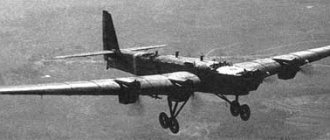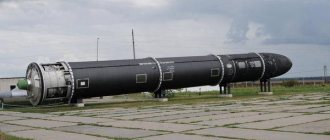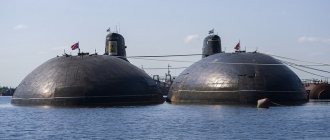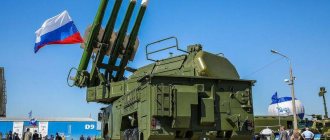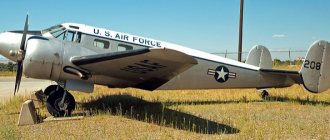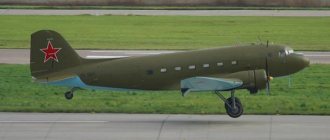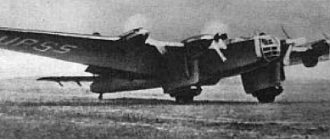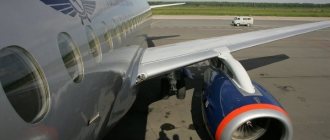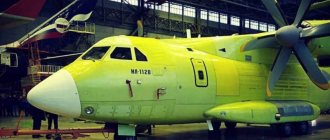LONG LONG AVIATION OF RUSSIA
TU-95MS BEAR, a Russian strategic missile-carrying bomber, has undoubtedly remained the basis of strategic aviation for over half a century.
Strategic bomber TU-95MS BEAR
Tu-95MS BEAR is a Soviet and Russian turboprop strategic missile-carrying bomber, the world's fastest aircraft with turboprop engines. Other names - project “95”, product “B”, according to NATO codification: Bear - “Bear”.
To date, the Bear is the world's only serial bomber and missile carrier with turboprop engines. Not only was it a Soviet symbol of ensuring military-strategic parity in the Cold War, but it also remains in service today as a cruise missile carrier. Compared to jet aircraft, the Bear has lower fuel consumption. It also has great stealth from SBIRS satellites, capable of monitoring large strategic bombers with jet engines based on the exhaust from the latter.
National Interest notes that it is certainly quite naive to consider the Tu-95 an “obsolete weapon.” Since in fact nothing is required from such an aircraft except to fly over a long range. Because its real weapons, as is known, are the latest X-101 cruise missiles. As a result, with a range of 5,500 km, they allow the Tu-95 to attack targets beyond the range of any air defense systems with “impunity.” The practical use of the Tu-95 in Syria has indisputably proven that the aircraft is not an “abstract nuclear deterrent.” It can actually be used in modern local wars.
The history of the creation and combat service of this unique aircraft and the pride of the Russian Aerospace Forces.
Background
The first attempt to create an intercontinental bomber in the USSR was a deep modernization of the Tu-4. Airplane 80 (its first flight took place on December 1, 1949) covered a distance of 8,000 km. However, the Korean War, which began soon after, convincingly showed the futility of developing long-range bombers based on piston engines: jet fighters left it less and less chance of breaking through to protected objects. That is why, despite the possibility of achieving a range of more than 12,000 km, further work on the next Soviet strategic bomber, the Tu-85, was stopped. As a new model of such a machine, it was planned to create a bomber with a maximum speed of about 900-950 km/h, a payload capacity of up to 20 tons, a flight range of up to 14-15 thousand km and a flight altitude of 13-14 thousand m.
To meet such high requirements, it was necessary to apply a new aerodynamic design and use not only a powerful, but also a lightweight power plant, which also had acceptable fuel consumption. There was practically no other opportunity to achieve intercontinental range with all other parameters. Based on TsAGI developments on the aerodynamics of a swept wing and optimization of its design, the A. Tupolev Design Bureau selected the aerodynamic design of a multi-engine aircraft with a 35° swept wing. The layout of its fuselage, crew accommodation, weapons systems and target equipment developed the ideas embodied in the Tu-85, but the presence of a swept wing made it possible to place a large bomb bay behind the wing center section box, which was located near the center of gravity of the aircraft.
Selecting a power plant
The most difficult task was the choice of the power plant and the option for its placement on the aircraft. According to calculations carried out by the design bureau, it was impossible to obtain the required flight performance characteristics, especially for the maximum flight range, using turbojet engines, which the customer insisted on. What the Tupolev Design Bureau “had” at that time was the AM-3 turbojet engine with a thrust of 8700 kgf and the AL-5 with a thrust of 5000 kgf. True, by the end of the forties, OKB V Klimov created a prototype VK-2 turboprop engine with a power of 4820 hp, with a low specific fuel consumption of 326 g/hp. and a specific gravity of 290 g/hp, but the development of this engine has so far been limited to bench tests.
At the same time, the N. Kuznetsov Design Bureau, relying on the work of interned German specialists, presented the TV-2 turboprop engine with a power of 6260 hp for testing. and completed the design of the TV-12 with a fantastic power of 12,000 hp at that time.
The Tupolev Design Bureau carefully studied aircraft options with almost all promising aircraft engines developed in the USSR: turbojet engines, turbojet engines in combination with piston engines, in combination with turboprop engines. Various power plant layouts were studied. In particular, a preliminary design was completed on the topic, in which six AM-3 type turbojet engines were located on both sides of the fuselage, in pairs, one above the other, and two more engines were located in the fuselage below, behind the wing. All this looked very exotic, but even according to the first estimates, it did not allow us to achieve the specified performance characteristics.
As a result, it was concluded that four theater engines with a total power of at least 40,000 hp correspond to the greatest extent to the required aircraft.
Code "95"
The new aircraft received the code “95” at the OKB. The head of work on the topic was N. Bazenkov, later the chief designer of all the numerous variants of the Tu-95 family. In 1976, after his death, N. Kirsanov became the chief designer for all aircraft of the Tu-95 series.
According to the decree on the creation of "95", issued on July 11, 1951, the aircraft was required to be manufactured in two copies. The first with twin TV-2 motors (2TV-2F) and the second with TV-12. The power in both versions was about 12,000 hp. for each engine.
The take-off weight of the new aircraft was determined to be 150 tons, so it was necessary to scrupulously approach issues related to the structural strength of the bomber. First of all, this applied to the swept wing, which had a large span and aspect ratio, and had high aerodynamic properties. The presence of four unusually powerful motors with propellers on the wing required the search for new design solutions to ensure its vibration resistance. At the same time, Tupolev paid special attention to compliance with the conditions for every possible compaction of the layout.
The solution to the complex problem fell to the K. Zhdanov Design Bureau, which developed a gearbox and coaxial four-blade propellers with the opposite direction of rotation. There were no analogues in world aviation practice in those years. A design with two coaxial screws rotating in opposite directions was used to reduce the diameter of the screw. As a result, the Tu-95 was equipped with a unique planetary gearbox and propeller with unusually high efficiency in all modes, which remain unsurpassed to this day. The OKB began producing working drawings in September 1951. At the same time, production of the first copy began, and a year later the first prototype was ready.
The objectives of testing this aircraft were to test in the shortest possible time the correctness of the chosen concept of a strategic intercontinental bomber, and to test all its systems and equipment in real conditions. The “95/1” was a purely experimental vehicle, preparing the way for the “95/2” with the TV-12 theater. The “95/1” took flight with a crew led by test pilot A. Perelet on November 12, 1952. The car was in the air for 50 minutes.
Failures
All winter and spring of the following year he was tested. On the seventeenth flight, an accident occurred: the third engine caught fire. Despite all the attempts of the crew, the fire could not be extinguished, and A. Perelet gave the command to abandon the plane. On board, without stopping attempts to save the car, only he and flight engineer A. Chernov remained. When leaving the plane, navigator Kirichenko and NISO engineer Bolshakov died, the rest of the crew remained alive.
During the investigation, it was established that the fire occurred as a result of the destruction of the intermediate gear of the third 2TV-2F engine gearbox due to its insufficient strength and was not extinguished due to the insufficient effectiveness of aircraft fire extinguishing equipment.
The disaster was deeply felt by the entire design bureau team, but the second prototype was already under construction, and the task was to take into account all the identified shortcomings and omissions in it, and to use the experience of fine-tuning the first Tu-16.
In July 1954, the 95/2 aircraft was manufactured and until December of the same year stood waiting for TV-12 engines, which were brought to condition. At the Design Bureau of K. Zhdanov and N. Kuznetsov, each unit was checked with special care.
First takeoff of '95
In January 1955, the “backup” was taken to an experimental airfield, and on February 16, the crew led by test pilot M. Nyukhtikov (2nd pilot I. Sukhomlin) made the first takeoff on “95/2”. Its factory tests were completed at the beginning of 1956. By this time, aircraft production was already underway at Kuibyshev plant No. 18. The first two production 95 aircraft took off in October 1955, after which state tests were carried out on three aircraft.
At the same time, the following results were obtained for the “95/2” aircraft: maximum speed - 882 km/h, flight range with a bomb load of 5 tons - 15,040 km, ceiling - 11,300 m. In terms of speed and ceiling, the data did not meet the customer’s requirements, therefore New engines were installed on the second production vehicle (NK-12M instead of NK-12), which already had a take-off power of 15,000 e. l. With. and lower fuel consumption. The aircraft had increased fuel capacity and take-off weight. In September-October 1957, it reached a maximum speed of 905 km/h, a ceiling of 12,150 m, and a range of 16,750 km.
Mass production
The bomber was accepted for mass production and produced since 1955 in two modifications: Tu-95 and Tu-95M. Soon the first of them began to receive combat units. It was adopted into service in August 1957 and became the main Soviet strategic deterrent at the height of the Cold War until the first ballistic intercontinental missiles were adopted in the sixties.
The Tu-95 and Tu-95M were in serial production until 1959; Several aircraft were produced in the Tu-95MR strategic reconnaissance version. Two cars were converted into passenger cars and used for special transportation. On these aircraft, the bomb bay housed a pressurized cabin for 20-24 people. They were called Tu-116 and were used by the Air Force until the end of the eighties.
Tu-95 bombers were designed to carry out bombing attacks, including nuclear weapons, on strategic targets located deep behind enemy lines. At the time of its creation, it was believed that the combination of high flight speed, altitude and powerful defensive weapons made strategic aircraft practically invulnerable to the then air defense systems. Small arms and cannon weapons (6 23 mm caliber guns) made it possible to provide almost spherical protection from enemy fighter aircraft. The stern installation was equipped with an Argon radar gun sight. The bomb load of the Tu-95 varied from 5 to 15 tons depending on the flight range. The maximum caliber of bombs placed on the internal sling was 9 tons.
The Tu-95 equipment was equipped with the most modern systems of that period, which made it possible to perform flights in difficult weather conditions.
Peculiarities
On the first Tu-95, the crew included eight people: two pilots, a navigator, a flight engineer, a navigator-operator, a gunner-radio operator (in the front pressurized cabin) and two gunners in the aft cabin. A feature of the escape system on the Tu-95, unlike other jet bombers of that time, was the absence of ejection seats.
From the front cabin, in an emergency, the crew left the bomber through the open hatch of the nose landing gear using a movable conveyor, and the rear gunners were thrown down through the hatches.
In March 1957, the Tu-95 crashed. The failure of one engine should not have led to a catastrophic situation, but on this flight the system for moving the propellers to the feathering position did not work. Very promptly, a few months later, NK-12MV engines with automatic and manual feathering were put into production. Until now, the NK-12 engine is the most powerful turboprop engine in the world.
Strengthening the potential enemy's air defense systems required the aircraft's developers to improve its performance characteristics. Back in 1952, an order was issued to build a high-altitude strategic bomber with a flight ceiling over a target of 17 thousand meters and a flight range at that altitude of up to 9000-10000 km, with a combat load of 5 tons and a speed of 800-850 km/h. It was supposed to install new NK-16 engines, high-altitude and more powerful. The car was named Tu-96. It had slightly larger dimensions, a new fuselage, bow cockpit and center section design. In 1956, the aircraft entered factory testing. But by this time it had already become clear that the high flight altitude would not save the bomber from attacks by supersonic interceptor fighters and anti-aircraft missiles. Work on the Tu-96 was stopped.
Creation of new aircraft and missile systems
The main direction in increasing the efficiency of strike aviation forces in the mid and second half of the fifties was the creation of aircraft-missile systems that used the long range of the carriers and the invulnerability of the projectile aircraft launched from the carrier several hundred or thousand kilometers from the target. This combined option was supposed to increase the survivability of the strike system.
The aviation and missile system, named Tu-95K-20, began to be developed in March 1955. The carrier aircraft underwent alterations: a new nose section was designed, where radars were installed to detect the target and point the projectile aircraft at it. The A. Mikoyan Design Bureau created the X-20 projectile aircraft for the complex with a range of 350 km and a flight speed corresponding to 2M. The X-20 was located in the bomb bay on a special holder, which raised the projectile up before flight and lowered it before launch.
The carrier prototype, Tu-95K, was lifted into the air on January 1, 1956. Finishing work on the complex has begun. To test the X-20 systems, OKB specialists converted a serial MiG-19 (SM-20 aircraft), on which the guidance system, suspension and release from the carrier aircraft were tested in a manned version.
Due to the novelty of the subject, testing and fine-tuning of the complex were delayed, and only in September 1959 the Tu-95K-20 was officially accepted into service. As a result of modifications to the Tu-95, its aerodynamics deteriorated, resulting in a decrease in flight range. Air refueling could have saved the situation. In the spring of 1960, the A. Tupolev Design Bureau was tasked with developing a “hose-cone” refueling system for the Tu-95K. A year later, the first Tu-95K was equipped with such a system and received the name Tu-95KD. Both options. “K” and “KD” were mass-produced until 1965, which significantly increased the combat capabilities of domestic strategic aviation.
Long-range reconnaissance and target designation device
In the sixties, some of the K series aircraft had their radio and navigation equipment updated, after which the aircraft received the Tu-95KM designation. At the beginning of the next decade, it was decided to convert the Tu-95K and Tu-95KD into carriers of air-to-ground guided missiles, similar to those used on the Tu-22 and Tu-22M supersonic bombers. The new complex, Tu-95K-22, included one or two missiles, suspended on underwing pylons or in the cargo bay.
The prototype Tu-95K-22, developed on the basis of the serial Tu-95K, first took off from the runway in October 1975. After testing was completed in the late seventies, modifications to the Tu-95K-22 fleet of Tu-95K aircraft began. Since the beginning of the eighties, the vehicles entered combat units in a new quality.
As you know, in the first half of the sixties, the USSR Navy began to enter the ocean. Its submarine and surface forces required a means of long-range reconnaissance and target designation. Already in 1962, the Tu-95RTs entered testing. For two years, the entire complex of radar and radio engineering systems of the new vehicle was refined and brought up to standard, and in 1964 its deliveries to the Navy aviation began.
A special place among the Tu-95 modifications is occupied by the Tu-126 early warning aircraft, equipped with the Liana radar complex. Work on it began back in 1960. The first prototype was ready two years later. In 1965-1967, eight more Tu-126s were produced. All nine aircraft were in service until the early eighties, when they were replaced by the more advanced A-50.
Against submarines
One of the most important components of the American nuclear “triad” since the sixties has been a combination of nuclear submarines equipped with submarine-launched ballistic missiles. To combat them, the USSR in 1963 began developing a long-range anti-submarine strike system based on the Tu-95, capable of detecting and destroying submarines on the surface and underwater. In the summer of 1968, the experimental Tu-142 made its first takeoff. It differed from the Tu-95 in its target equipment, a new wing design and a reduced number of small arms and cannon weapons. Initially, the Tu-142 had original main landing gear bogies with six wheels, which ensured the possibility of using unpaved runways. Tu-142 aircraft entered service with the Navy aviation in December 1972.
In the seventies, the combat capabilities of nuclear missile submarines increased significantly, which required the modernization of anti-submarine weapons, including aircraft anti-submarine systems. At the OKB named after A.N. Tupolev, under the general leadership of general designer A. Tupolev, in 1972 initiated work on modernizing the Tu-142. As a result, they created the Tu-142M aircraft, which was equipped with equipment for detecting low-noise submarines, a more accurate inertial navigation system, an updated automated radio communication system, a Ladoga magnetometer, and the front cockpit was completely changed. The first flight of the Tu-142M was made by test pilot I. Vedernikov on November 4, 1975. Since 1980, this machine has been successfully operated in parts. Based on the Tu-142M, the Tu-142MR repeater aircraft was subsequently developed for the needs of the submarine fleet.
Missile carrier with cruise missiles
Work in the United States to modernize strategic strike aircraft systems based on the B-52 and arm them with cruise missiles caused a response from the Soviet side. The start of work on re-equipping the Tu-95 fleet with new missiles can be dated back to the early seventies, when the Tu-95M-5 (Tu-E5K-26 complex) was produced on a trial basis, armed with two KSR-5 missiles used on the Tu-16K -26. However, this direction has not received development.
In 1976, also on a trial basis, one of the production copies of the Tu-95M was converted into a missile carrier with air-launched cruise missiles - the Tu-95M-55. In 1978, it passed factory tests, but this time there was no decision to convert the fleet aircraft.
At the same time, based on the Tu-142M, work was carried out on a strategic carrier of cruise missiles. The new version, called the Tu-95MS, made its first flight in September 1979, and in the early eighties it entered service, and to this day is in service with the strategic aviation of the Russian Aerospace Forces.
Unbreakable
Tu-95MS has very high defensive capabilities. The crews assessed the plane as literally unbreakable. The airborne defense system (ADS) of this vehicle has become the most advanced in our country and has surpassed the complex of the American B-52N in many respects. At MS it was possible to successfully resolve the problems of electromagnetic compatibility, which spoiled so much blood during the creation of the Tu-160. In the summer of 1987, during specially conducted tests, its electronics managed to brilliantly thwart all attempts to carry out attacks on the most modern and electronically equipped MiG-31 interceptor. The flight took place at night in simple weather conditions at an altitude of 8000 m. The crew of the thirty-first reported: “I am observing the target visually, I can work with a cannon, it is impossible to carry out a tactical launch.” It is worth noting that the characteristics of the MiG-31 airborne system were significantly superior to those of the American F-15. As you can see, by the end of the last century, the stern gun again returned to its previous meaning.
Combat duty was again organized on these vehicles. At the same time, its crews were no longer subject to the same psychological stress that their predecessors who flew bombers experienced. They did not need to enter the range of powerful air defense, and besides, they did not know their targets, or even the launch point. The crew’s task was to bring the attack vehicle to a certain point, from where it would automatically fly for another hour, after which it would also independently launch missiles.
Passenger version
One of the most famous modifications of the Tu-95 bomber was its passenger version - the Tu-114. Work at the Design Bureau on this aircraft began in 1955. The prototype was flown into the sky by test pilot A. Yakimov on November 10, 1957. State tests ended in July 1960, and operational tests ended in March of the following year.
On April 24, 1961, the first flight of the Tu-114 with passengers on board took place, traveling from Moscow to Khabarovsk. In total, until 1965, 31 Tu-114s were built at the Kuibyshev aircraft plant. They successfully served on domestic and international routes until 1980. During this period, more than 6 million passengers were transported. The airliner was produced in configurations for 170 and 200 seats. In 1962, an option was prepared for flights to Cuba: as a result, the number of passenger seats was reduced to 120 due to an increase in fuel supply. Since January 1963, regular flights to Havana began, with one stopover.
The Tu-114 set 32 world records. In addition, in 1958, the airliner was awarded the “Grand Prix” at the Brussels International Exhibition, and A.N. Tupolev was awarded the FAI Grand Gold Medal.
Various flying laboratories were also created, where promising aircraft engines, equipment and aircraft systems were tested. There were many unfulfilled projects of carrier aircraft for various types of manned and unmanned objects. The Tu-95, the only aircraft of its class with a theater of operations in the world, has gone through a glorious and difficult path, from its birth to the present day.
TTX TU-95MS
Tactical and technical characteristics of the TU-95MS strategic bomber-missile carrier.
| Modification | 95-1 (prototype) | TU-95MS |
| Specifications | ||
| Crew | 9 | 7 |
| Length, m | 44,35 | 49,09 |
| Wingspan, m | 49,8 | |
| Wing area, m2 | n/a | 289,9 |
| Wing aspect ratio | 8,7 | 8,84 |
| Empty weight, kg | 86300 | up to 98500 |
| Maximum take-off weight, kg | 156000 | 185000 |
| Fuel weight, kg | up to 60000 | 87000 |
| Power point | 4 x 2TV-2F | 4 x NK-12MP |
| Engine power, kW (hp) | 4 x 8948 (12000) | 4 x 11185 (15000) |
| Flight characteristics | ||
| Maximum speed, km/h | 945 | 830 |
| Cruising speed, km/h | n/a | up to 700 |
| Practical range, km | 15200 | 10500 |
| Combat radius, km | n/a | 8300 Combat radius of action - in military affairs - the maximum distance at which an aircraft (helicopter), group (formation) can complete a given combat mission with the established refueling, given mode and flight profiles and return to the take-off airfield without consuming the guarantee reserve and emergency reserve of fuel. The combat radius with one refueling is 8300 km, according to information from https://militaryrussia.ru/blog/topic-246.html |
| Practical ceiling, m | 13700 | 10500 |
| Wing load, kg/m2 | 548 | 638 |
| Run length, m | 1580 | 2540 |
| Run length, m | 1370 | n/a |
| Armament | ||
| Small arms and cannon | 3 × 2 × AM-23 | 2 × GSh-23 |
| Combat load kg (normal / maximum) | 5000/15000 | 7800 / 20800 |
In 2010, the Tu-95 crew made a record flight of almost 30 thousand kilometers with four refuelings over three oceans.
Scheme
The total number of developed variants of the 95 aircraft, including not only serial modifications, but also prototypes, flying laboratories and unfulfilled projects, is close to fifty. In total, from 1955 to 1992, more than 500 Tu-95 aircraft of various modifications were produced.
Flying laboratories for various purposes were created based on modifications of the Tu-95. As well as the passenger intercontinental airliner - Tu-114 and its design transport version. In turn, on the basis of the Tu-114, the AWACS combat aircraft, the Tu-126, was created. A direct development of the “95” project at a higher aviation-technical level was a variant of the PLO aircraft. In the series, he formed a modified series of aircraft of the Tu-142 family for various combat purposes.
Modifications
Tu-95 is the first modification of the bomber. Tu-95A - carrier of nuclear battery, development of the previous modification; It is distinguished by the presence of a thermally stabilized bomb bay, light-protection curtains in the cockpit and a special coating. Tu-95V - serial Tu-95, converted as a carrier of thermonuclear batteries in 1959. Special development only for testing a heavy-duty (50-100 Mt) nuclear reactor on Novaya Zemlya. Released only in a single copy.
more details
Aircraft for the Tsar Bomba
In October 1961, the Soviet Union tested the world's most powerful thermonuclear bomb.
To drop ammunition weighing 26 tons onto Novaya Zemlya, a special Tu-95V aircraft was designed. Since the Tsar Bomba did not fit in the weapons bay, the bomb bay covers were removed, all electrical connectors were replaced, and the fuselage was painted with white reflective paint. At the moment of the explosion of the Tsar Bomba, its carrier was 39 kilometers from the epicenter at an altitude of 11,500 meters. The electromagnetic pulse stopped three of the bomber's four engines. Crew commander Andrei Durnovtsev put the plane into a dive and started the engines on the move: the second at 7,000 meters, the third at 5,000. The fourth engine never started - after landing it turned out that it was badly burned. The paint on the fuselage was also charred here and there. Durnovtsev flew to Novaya Zemlya as a major and returned as a lieutenant colonel. Another six months later he became a Hero of the Soviet Union. Based on the Tu-95, carriers of the Spiral orbital aircraft and the supersonic cruise missile X-20, a flying laboratory for the nuclear aircraft program and a naval reconnaissance target designator, the passenger Tu-114 and the submarine hunter Tu-142 were created. Unlike Tu-160, which are named after famous pilots, personalized Tu-95 are named after Russian cities. For example, a bomber with tail number 12 is called “Moscow”, naval reconnaissance aircraft No. 53 is called “Vanino”.
TO
Tu-95K is a missile carrier aircraft armed with the K-20 complex, which included the Kh-20 missile launcher. As you know, 2 prototypes were produced, converted from Tu-95s under construction. The first of them took off on January 1, 1956. The release was carried out in 1958-1962. Tu-95K-22 - a missile-carrying aircraft that received the K-95-22 complex with the X-22 missile launcher; converted from Tu-95 KM; the lead vehicle took off on October 30, 1975. Tu-95KD - Tu-95K, equipped with an in-flight refueling system: the prototype was finalized and made its first flight on July 5, 1961, since 1962 more than 20 vehicles have been produced, and also several previously produced Tu-95 K. Tu have been converted -95KM - Tu-95KD, passed in the late 60s. modernization by installing new avionics and rearmament of the X-22M missile launcher. Tu-95KU - Tu-95K, converted into training aircraft for training crews to work with the equipment of the K-20 complex.
Tu-95LAL - experimental Tu-95 with a nuclear reactor. "Flying Atomic Laboratory" Tu-95M - further development of the Tu-95 with an NK-12M turboprop engine; made its first flight in September 1957; by the end of 1958, 19 aircraft were produced. Tu-95M-5 - Tu-95M, converted in October 1976 into a carrier for the KSR-5 missile launcher; remained in the prototype. Tu-95MA - nuclear-powered aircraft carrier; changes - similar to Tu-95A; mass-produced. Tu-95MR - reconnaissance aircraft.
MS
Tu-95MS is a carrier aircraft of the KR X-55/RKV-500A with a crew of seven people. The prototype made its first flight in 1979. Production until 1983 was carried out at the Taganrog Aviation Plant, and then was transferred to Kuibyshev. Tu-95N - carrier aircraft of the supersonic PC bomber designed by P.V. Tsybin; the prototype was converted from a serial product in 1958, the topic was not further developed. Tu-95RTs - reconnaissance target designator for naval aviation; The prototype made its first flight on September 21, 1962; the aircraft was produced in series since 1963. Tu-95U is a training version of the Tu-95/Tu-95M, intended for training Tu-95 crews of later modifications; in the 80s A number of old aircraft have been converted. Tu-96 - high-altitude bomber; The prototype was tested in the summer of 1956; the modification was not mass-produced. Tu-116 is a long-range passenger aircraft for transporting government officials. In 1956 and 1957, two production bombers were converted. Tu-119 is an experimental Tu-95 with a nuclear reactor.
Personalized TU-95
Honorary names of cities are assigned to strategic missile carriers Tu-95MS only at the request of city authorities. Cities with which the history of the origin, creation and development of Long-Range Aviation, its associations, formations and units is connected. The decision to assign an honorary name to an aircraft is made by the Military Council and announced by order of the commander of Long-Range Aviation.
Today, for example, more than 20 Long-Range Aviation aircraft have honorary names of cities: Irkutsk, Mozdok, Kurgan, Saratov, Vorkuta, Moscow, Voronezh, Kaluga, Veliky Novgorod, Veliky Ustyug, Krasnoyarsk, Dubna, Ryazan, Samara, Kozelsk, Chelyabinsk , Tambov, Izborsk, Sevastopol, Smolensk, Vanino (Khabarovsk Territory), Blagoveshchensk, Klin, Orenburg, Pskov, Tver.
Serial production of Tu-95K aircraft
Tu-95K (ed. VK) serially built by plant No. 18 , long-range (intercontinental) strategic missile-carrying aircraft - carrier of the X-20M projectile aircraft. The decision to launch a series of all elements of the K-20 system was made in July 1958. 47 copies were built, the first two were delivered on July 31, 1959, the last in December 1962.
Of these, 24 were converted into Tu-95KM (KD), and then into Tu-95K-22, see.
The Tu-95K aircraft was in service with the USSR from 1959 to 1991.
Of the remaining ones, some were converted into Tu-95KU, the rest in the early 90s. disposed of.
Series 20. Numbering continued as the production of Tu-95M aircraft continued, which was discontinued in favor of the Tu-95K. A total of 7 aircraft were produced, the first two on July 31, 1959, the last in July 1960. Three of them were subsequently converted into the Tu-95KM, and then into the Tu-95K-22. Lost 2.
Tu-95K No. 8802004 . Delivered - 08.59. Crashed 01/05/63.
Tu-95K No. 8802005 . Delivered on July 31, 1959. Converted to Tu-95KM. Converted to Tu-95K-22. In the mid-80s. was part of the 182nd TBAP.
Tu-95K No. 8802006 . Delivered on July 31, 1959. Converted to Tu-95KM. In the mid-80s. was part of the 1006th TBAP. Converted to Tu-95K-22 and transferred to another unit.
Tu-95K No. 9802007 . Delivered on September 30, 1959. In the mid-80s. was part of the 1006th TBAP.
Tu-95K No. 9802008 (board 12) . Delivered on July 31, 1959. Converted to Tu-95KM. In the mid-80s. was part of the 1006th TBAP. Converted to Tu-95K-22 and transferred to another unit.
Tu-95K No. 9802009 . Delivered on January 30, 1960. In the mid-80s. was part of the 182nd TBAP.
Tu-95K No. 9802010 . Delivered - 07.60. Crashed 08.26.77.
Series 21. A total of 10 aircraft were delivered, the 1st on 08/31/59, the last two on 12/30/59. Of these, 7 were converted into Tu-95KM, and then all of them into Tu-95K-22.
Tu-95K No. 9802101 . Delivered on August 31, 1959. Converted to Tu-95KM. Converted to Tu-95K-22. In the mid-80s. was part of the 182nd TBAP.
Tu-95K No. 9802102 . Delivered on September 30, 1959. Converted to Tu-95KM. In the mid-80s. was part of the 182nd TBAP.
Tu-95K No. 9802103 . Delivered on September 26, 1959. Converted to Tu-95KM. In the mid-80s. was part of the 1006th TBAP. Converted to Tu-95K-22 and transferred to another unit.
Tu-95K No. 9802104 . Delivered on September 30, 1959. Converted to Tu-95KM. Converted to Tu-95K-22. In the mid-80s. was part of the 182nd TBAP.
Tu-95K No. 9802105 . Delivered on October 31, 1959. In the mid-80s. was part of the 182nd TBAP.
Tu-95K No. 9802106 . Delivered on October 31, 1959. In the mid-80s. was part of the 182nd TBAP.
Tu-95K No. 9802107 . Delivered on October 31, 1959. Converted to Tu-95KM. In the mid-80s. was part of the 1006th TBAP. Converted to Tu-95K-22 and transferred to another unit.
Tu-95K No. 9802108 . Delivered on November 30, 1959. Converted to Tu-95KM. Converted to Tu-95K-22. In the mid-80s. was part of the 1226th TBAP.
Tu-95K No. 9802109 . Delivered on 12/30/59. Converted to Tu-95KM. Converted to Tu-95K-22. In the mid-80s. was part of the 182nd TBAP.
Tu-95K No. 9802110 . Delivered on 12/30/59. Converted to Tu-95KM. Converted to Tu-95K-22. In the mid-80s. was part of the 182nd TBAP.
Series 22. 10 aircraft built. The first two were delivered on 12/31/59, the last one on 10/31/60. 6 of them were converted into Tu-95KM, and then all of them into Tu-95K-22. After completion of operation, one was transferred for statistical testing. 1 plane crashed.
Tu-95K No. 9802201 . Delivered on December 31, 1959. In the mid-80s. was part of the 1006th TBAP.
Tu-95K No. 9802202 . Delivered on December 31, 1959. Converted to Tu-95KM. Converted to Tu-95K-22. In the mid-80s. was part of the 1226th TBAP.
Tu-95K No. 9802203 . Delivered on January 30, 1960. Converted to Tu-95KM. In the mid-80s. was part of the 1006th TBAP. Converted to Tu-95K-22 and transferred to another unit.
Tu-95K No. 2204 . Delivered in 1960. Submitted for statistical testing.
Tu-95K No. 2205 . Delivered on February 29, 1960. Converted to Tu-95KM. Converted to Tu-95K-22. In the mid-80s. was part of the 1226th TBAP.
Tu-95K No. 60802206 . Delivered on March 31, 1960. Converted to Tu-95KM. In the mid-80s. was part of the 1006th TBAP. Converted to Tu-95K-22 and transferred to another unit.
Tu-95K No. 60802207 . Delivered on March 31, 1960. Converted to Tu-95KM (the first among the entire Tu-95K fleet). Converted to Tu-95K-22. In the mid-80s. was part of the 182nd TBAP.
Tu-95K No. 60802208 . Delivered on October 24, 1960. In the mid-80s. was part of the 182nd TBAP. Converted to Tu-95KM, and then to Tu-95K-22.
Tu-95K No. 60802209 . Delivered 09/30/60. Crashed 12/24/87.
Tu-95K No. 60802210 . Delivered on October 31, 1960. In the mid-80s. was part of the 182nd TBAP
Serial intercontinental missile carrier Tu-95K aircraft in long flight Photo: Airfighters.com
Series 23. 9 aircraft built. The first 2 were delivered on September 30, 1960, the last 3 in December 1960. Of these, 3 were converted into Tu-95KM, and then all 3 into Tu-95K-22
Tu-95K No. 60802301 . Delivered 09/30/60. Crashed 08/26/77.
Tu-95K No. 60802303 . Delivered on September 30, 1960. Converted to Tu-95KM. In the mid-80s. was part of the 1006th TBAP. Converted to Tu-95K-22 and transferred to another unit.
Tu-95K No. 60802304 . Delivered on October 31, 1960. In the mid-80s. was part of the 182nd TBAP.
Tu-95K No. 60802305 . Delivered on November 18, 1960. Converted to Tu-95KM. Converted to Tu-95K-22. In the mid-80s. was part of the 1226th TBAP.
Tu-95K No. 60802306 . Delivered on December 12, 1960. In the mid-80s. was part of the 182nd TBAP.
Tu-95K No. 60802307 . Delivered on December 12, 1960. In the mid-80s. was part of the 182nd TBAP.
Tu-95K No. 60802308 . Delivered - 12.60. In the mid-80s. was part of the 1226th TBAP.
Tu-95K No. 60802309 . Delivered on November 30, 1960. Converted to Tu-95KM. Converted to Tu-95K-22. In the mid-80s. was part of the 1226th TBAP.
Tu-95K No. 60802310 . Delivered on November 30, 1960. In the mid-80s. was part of the 1226th TBAP
Series 24. 10 aircraft built. The first 3 were delivered on 05/31/61, the last - on 11/30/61. Of these, 6 were converted into Tu-95KM, and then these 6 aircraft were converted into Tu-95K-22.
Tu-95K No. 60802401 . Delivered on November 30, 1960. Converted to Tu-95KM. Converted to Tu-95K-22. In the mid-80s. was part of the 1226th TBAP.
Tu-95K No. 61802402 . Delivered on 05/31/61. Converted to Tu-95KM. Converted to Tu-95K-22. In the mid-80s. was part of the 182nd TBAP.
Tu-95K No. 61802403 . Delivered on 05/31/61. Converted to Tu-95KM. In the mid-80s. was part of the 1006th TBAP. Converted to Tu-95K-22 and transferred to another unit.
Tu-95K No. 61802404 . Delivered on 05/31/61. Converted to Tu-95KM. Converted to Tu-95K-22. In the mid-80s. was part of the 1226th TBAP.
Tu-95K No. 61802405 . Delivered on June 30, 1961. In the mid-80s. was part of the 1006th TBAP.
Tu-95K No. 61802406 . Delivered on September 30, 1961. Converted to Tu-95KM. Converted to Tu-95K-22. In the mid-80s. was part of the 1226th TBAP.
Tu-95K No. 61802407 . Delivered on September 30, 1961. In the mid-80s. was part of the 1226th TBAP.
Tu-95K No. 61802408 . Delivered on September 30, 1961. In the mid-80s. was part of the 1226th TBAP.
Tu-95K No. 61802409 . Delivered on October 31, 1961. In the mid-80s. was part of the 1226th TBAP.
Tu-95K No. 61802410 . Delivered on November 30, 1961. In the mid-80s. was part of the 1006th TBAP. Converted to Tu-95K-22 and transferred to another unit.
Series 25. 1 vehicle was delivered as the Tu-95K.
Tu-95K No. 61802501 . Delivered - 12.61. In the mid-80s. was part of the 1226th TBAP.
Serial production of Tu-95KM
Series 25. The first aircraft was produced in the Tu-95K variant, then the numbering continued. 9 aircraft were delivered as Tu-95KM. The first one was delivered on 04/24/62 (presumably), the last one on 12/30/62. All of them were converted into Tu-95K-22.
Tu-95KM No. 62M52502 (the first production Tu-95KM). Commissioned in 1962 (at the beginning of the year?). Converted to Tu-95K-22. In the mid-80s. was part of the 1226th TBAP.
Tu-95KM No. 62M52503 . Delivered on November 30, 1962. Converted to Tu-95K-22. In the mid-80s. was part of the 1226th TBAP.
Tu-95KM No. 62M52504 . Delivered on June 30, 1962. In the mid-80s. was part of the 1006th TBAP. Converted to Tu-95K-22 and transferred to another unit.
Tu-95KM No. 62M52505 . Delivered on June 30, 1962. Converted to Tu-95K-22. In the mid-80s. was part of the 1226th TBAP.
Tu-95KM No. 62M52506 . Delivered on June 26, 1962. In the mid-80s. was part of the 1006th TBAP. Converted to Tu-95K-22 and transferred to another unit.
Tu-95KM No. 62M52507 . Delivered on April 24, 1962. Converted to Tu-95K-22. In the mid-80s. was part of the 1226th TBAP.
Tu-95KM No. 62M52508 . Delivered on August 31, 1962. In the mid-80s. was part of the 1006th TBAP. Converted to Tu-95K-22 and transferred to another unit.
Tu-95KM No. 62M52509 . Delivered on September 29, 1962. Converted to Tu-95K-22. In the mid-80s. was part of the 1226th TBAP.
Tu-95KM No. 62M52510 . Delivered on December 30, 1962. Converted to Tu-95K-22. In the mid-80s. was part of the 1226th TBAP.
Serial intercontinental missile carrier Tu-95K in long flight Photo: defenseimagery.mil
Series 26. 10 aircraft were delivered, the first – 11/30/62, the last – 10/20/64. Of these, 9 aircraft were converted into the Tu-95K-22 variant, 1 into the carrier of the “105” aircraft
Tu-95KM No. 63M52601 . Delivered on November 30, 1962. Converted to Tu-95K-22. In the mid-80s. was part of the 1226th TBAP.
Tu-95KM No. 63M52602 . Delivered on February 28, 1963. Converted to Tu-95K-22. In the mid-80s. was part of the 1226th TBAP.
Tu-95KM No. 63M52603 . Delivered on March 31, 1963. Converted to Tu-95K-22. In the mid-80s. was part of the 182nd TBAP.
Tu-95KM No. 63M52604 . Delivered on April 30, 1963. Converted to Tu-95K-22. In the mid-80s. was part of the 182nd TBAP.
Tu-95KM No. 63M52605 . Delivered on June 29, 1963. Converted to Tu-95K-22. In the mid-80s. was part of the 182nd TBAP.
Tu-95KM No. 63M52606 . Delivered on August 31, 1963. In the mid-80s. was part of the 1006th TBAP. Converted to Tu-95K-22 and transferred to another unit.
Tu-95KM No. 63M52607 . Delivered in 1963. Transferred from the Air Force unit to the Air Force Research Institute, where it was converted into a carrier for the “105.11” aircraft.
Tu-95KM No. 63M52608 . Delivered on December 30, 1963. At the end of the 60s. was part of the 1006th TBAP. The first aircraft converted into Tu-95K-22. After modification, it was transferred to the combat TBAP.
Tu-95KM No. 63M52609 . Delivered on December 30, 1963. Converted to Tu-95K-22. In the mid-80s. was part of the 182nd TBAP.
Tu-95KM No. 63M52610 . Delivered on October 20, 1964. Converted to Tu-95K-22. In the mid-80s. was part of the 182nd TBAP.
Intercontinental missile carrier Tu-95KM in flight over the Atlantic on April 1, 1966. It is accompanied by an F-4B Phantom fighter from the VF-74 squadron and a KA-3 tanker from the VAH-11 squadron from the aircraft carrier Forrestal. Photo: airspacemag.com
Series 27. 4 aircraft delivered, 1st – 11/25/64, last – 09/28/65. All converted into Tu-95K-22
Tu-95KM No. 64M52701 . Delivered on November 25, 1964. In the mid-80s. was part of the 1006th TBAP. Converted to Tu-95K-22 and transferred to another unit.
Tu-95KM No. 64M52702 . Delivered on 12/30/64. Converted to Tu-95K-22. In the mid-80s. was part of the 1226th TBAP.
Tu-95KM No. 64M52703 . Delivered on September 28, 1965. Converted to Tu-95K-22. In the mid-80s. was part of the 182nd TBAP.
Tu-95KM No. 64M52704 . Delivered on 07/02/65. Converted to Tu-95K-22. In the mid-80s. was part of the 182nd TBAP.
Interesting facts and cases from aircraft operation
The first sad fact occurred on May 11, 1953 during a test flight. Due to the failure of the gearbox of the third engine, a fire broke out on the vehicle; the fire extinguishing system was unable to cope with the large flame. Crew commander test pilot A.D. The flight gave the command to the crew to abandon the plane; only he and flight engineer A.F. remained on board. Chernov, who realized that it was difficult for the commander alone to cope with the control of the aircraft and engines. At a distance of 40 km from the airfield, the burnt-out 3rd engine collapsed and came off, the car, descending steeply, crashed into swampy soil. In addition to the commander and flight engineer, navigator S.S. also died. Kirichenko (the explosion did not allow the parachute to fully open) and vibration testing technician A.M. Bolshakov (in his haste he forgot to put on his parachute).
Tu 95 take off
In the summer of 2015, two Tu 95MS , one after another, with a gap of less than a month. These accidents occurred due to crew fatigue during intensive NATO patrols.
In winter, when using a mixture of engine oils that froze at sub-zero temperatures until it was impossible to turn the propeller, it was necessary to warm up the engine with heat guns before starting. At operational airfields where there was no heating, the engines were covered with warm covers and started after a certain time, which negatively affected the service life and rest of personnel.
Design Features
Compared to modern aircraft, the Tu-95 looks rather archaic. This is not surprising, given the time of its creation, as well as the fact that individual components and structural elements were “borrowed” from the 85 piston bomber of the 40s.
Airplane glider
When creating the bomber, a normal aerodynamic design with a swept wing of high aspect ratio was used. The main load falling on the aircraft fuselage is distributed between the stringers, frames and skin. In addition, in the cargo compartment area, near the access hatches and near the front landing gear mounting, there are reinforcement elements that increase mechanical strength and ensure structural rigidity.
The forward part of the fuselage houses the cockpit, which was closed in front by a transparent canopy on early modifications. Constant air pressure is maintained inside the cabin, and a radar station is located directly below it. The cargo compartment, closed by two doors, is located in the middle part of the fuselage. It is not sealed, but is equipped with a heating system. At the rear of the aircraft there is another pressurized cabin for defensive installation operators.
The wing sweep is 35 degrees. Its components are a center section, two outer and two middle detachable parts. The tail consists of one fin and two low-mounted swept stabilizers.
Tu-95 aft cabin with open entrance hatch
Chassis
There are two main landing gear, both of them are biaxial. Each axle has paired wheels equipped with disc brakes. There is an automatic mechanism that prevents slipping and skidding. The cleaning of the main pillars is carried out using electric motors, while the carts are placed in gondolas installed on the wing of the aircraft.
The front landing gear is rotatable. It has two wheels, and cleaning is carried out either by hydraulics or by a backup pneumatic system. The nose strut niche is located at the front of the fuselage.
Power point
Tu-95 aircraft are equipped with four NK-12 engines of various modifications. The motors are placed in special nacelles built directly into the wing and extended relative to its leading edge. This scheme made it possible to prevent the occurrence of flutter. The power of each engine reaches 15,000 horsepower - this is still an unbroken record for turboprop engines.
An important part of the power plant is the planetary gearboxes, which transmit torque to the propellers, whose diameter is 5.6 meters.
Fuel system
On the wing consoles of the Tu-95 there are four necks through which centralized refueling of the aircraft is carried out. Fuel tanks, made of soft rubber, are located both in the fuselage and in the wings of the long-range bomber, and their total number can reach up to 74. Each engine receives fuel from its own independent system.
Engine nacelle with NK-12 engine of Tu-95 aircraft
Fuel consumption is controlled by an automatic system that ensures that the bomber remains centered. The possibility of emergency fuel drainage is provided.
As kerosene is produced, neutral gas is pumped into the tanks, which prevents fire in the event of various damages, including when the aircraft is fired upon.
Air system
Since a number of Tu-95 systems are equipped with emergency pneumatic drives, AK-150NK piston compressors are installed on the aircraft, providing air supply at a pressure of 150 kilograms per square centimeter. These devices are connected to the motors.
Hydraulic systems
The Tu-95 is equipped with hydraulic boosters, making it easier to control the aircraft. Power for these devices is provided by two 437F pumps. Both are connected to the bomber's propeller engines. Disc brakes, front wheel release and retraction, and cockpit windshield wipers are driven by a separate hydraulic system powered by an electrically driven pump. On early modifications, the upper defensive rifle installation was raised and lowered using hydraulics.
On Tu-95MS modification aircraft, an additional third hydraulic system was installed, consisting of two NS-46 pumps and two separate tanks. With the help of this equipment, the operation of the drum unit for launching cruise missiles is ensured.
Flight control system
The pitch and yaw angles of the aircraft are set using two control wheels located in the cockpit. The roll can be changed by two pairs of pedals. The connection with the elevators, direction and ailerons is cable, with rods and rockers. There are hydraulic boosters.
The cockpit of the Tu-95MS. The steering wheels are clearly visible
The aircraft is equipped with an AP-15 autopilot, which is electrically driven.
The ailerons and rudder are equipped with trim tabs, which are driven by electric actuators. The elevator trimmer is electrically controlled, but it is duplicated by a cable connection.
The Tu-95MS modification was equipped with an upgraded control system, which differed from the usual one in the ability to operate in emergency modes, for example, when one of the engines fails.
Anti-icing system
The Tu 95 aircraft is reliably protected from low temperatures. With the help of hot air coming from engine compressors, the inlet channels in the engine nacelles are heated.
Receivers of on-board instruments, fairings of hubs and leading edges of propellers, wing tips and horizontal tail, as well as glass in the cockpit are connected to an electric heating system.
The onset of the icing process is warned by radioisotope alarms and SO-4A sensors.
Electrical equipment
Each of the NK-12 engines is connected to two GSR-18000M DC generators. In emergency situations, emergency batteries 12СAM-55 can be used. Alternating current is created by four SGO-30U generators, which are also connected to Tu-95 engines. For frequency stabilization, three-phase converters PT-600 are used. Previously, PT-70 or a combination of PT-1000 and two single-phase PO-4500 were used.
Cargo compartment of Tu-95MS with open doors. Drum trigger visible
It should be noted that the composition of the on-board electronic equipment on the Tu-95MS has expanded significantly, which has led to a complication of the electrical circuit circuit diagram.
Tu-95KM aircraft with in-flight refueling system and new equipment
Tu-95KM (ed. VKM) serial production of plant No. 18 , intercontinental strategic missile-carrying aircraft - carrier of the X-20M projectile aircraft. The aircraft was distinguished by the installation of new equipment. For flight navigation equipment:
- the operating modes of the poison radar have been expanded;
- PNS “Put-1B” was installed;
- the KS-6D heading system was installed;
- a Doppler velocity and drift meter DISS-1 was installed;
- RSBN-2s installed;
- a low altitude altimeter RV-UM (RV-3) was installed instead of RV-2;
- a medium-wave automatic radio compass ARK-11 was installed instead of ARK-5;
- SPO-2 was replaced by SPO-3;
- SPS-2 was replaced by SPS-3;
- the PRS-1 “Argon” station on parts of aircraft was replaced with the PRS-4 “Krypton”;
- a common RTR station SRS-6/7 “Romb-4A/B” was installed on some aircraft.
A Tu-95KM aircraft in flight over international waters (photo from the cockpit of a NATO Air Force fighter). Antenna radomes for signals intelligence stations are installed on the fuselage. Photo: Jane's
The first production aircraft was delivered on April 24, 1962 (presumably). In 1962, 10 aircraft were delivered, in 1963 – 8, in 1964 – 3, in 1965 – 2. In total, the plant built 23 production Tu-95KM. The last one was delivered on September 28, 1965. Of these, 22 were converted into the Tu-95K-22 variant and 1 into the carrier of the “105” aircraft. In addition, the 2nd experimental Tu-95K No. 6800404 was also converted into the Tu-95KM variant, see.
The aircraft was in service with the USSR from 1962 to 1991.
Subsequently, some of the aircraft were put into storage, and the rest were sent for disposal. The decision was then made to scrap all aircraft to reduce costs, which was done by the end of the 1990s.
Tactical and technical characteristics of the aircraft
- Wing area – 289.9 m2
- Aircraft length – 49.13 m
- Aircraft height – 13.3 m
- Wingspan – 50.04 m
- Engines – 4 x NK-12MP
- Thrust - 4 x 15 thousand hp.
- Propellers – 4 x AB-60K, coaxial, reversible, variable pitch
- Empty aircraft weight – 94 t
- Maximum take-off weight – 185 t
- Highest speed – 830 km/h
- Cruising speed – 735 km/h
- Ceiling – 10500 m
- Practical range with six X-55s - 10520 km
- Standard weapons – 6 x X-55
- On pylons under the wing – 10 x X-55
- Small arms – NR-23 cannon
Tu-95KU training aircraft
Tu-95KU combat training missile-carrying aircraft. At the end of the 1970s. In connection with the expected arrival of new modifications of the Tu-95 - carriers of the SKR BD, a decision was made to transfer some of the Tu-95K and KM aircraft to training ones. The following modifications were supposed to be made to them:
- remove missile weapons (suspension and launch preparation means);
- remove part of the RMS YaD equipment that provides missile guidance (control panels, guidance channel), etc.
Modifications to the aircraft began at the turn of the 1970s.
During the SALT negotiations, which were led by the USSR and the USA, it was agreed upon to remove such aircraft from the list of considered strategic carriers, and since they should be externally different from combat aircraft, red stripes were applied to the fuselages.
By 2000, all Tu-95KUs were scrapped.
Recent use
In the spring of 2007, Russian missile carriers repeatedly observed British army combat exercises from the air. Similar incidents occurred in the Clyde Bay and off the Hebrides. However, each time, within a matter of minutes, British fighters took to the skies and, under the threat of attack, escorted the TU-95 beyond its borders.
From 2007 to 2008, missile carriers were spotted over NATO military bases and aircraft carriers. During this period, one TU-95 bomber crashed. There have been no official explanations about the causes of the accident.
Today, the Bears continue their worldwide intelligence activities.
Tu-95KD aircraft with in-flight refueling system
Tu-95KD project , an intercontinental missile carrier with a wing-to-wing in-flight refueling system. Due to the reduction in the flight range of the Tu-95K by almost 2000 km compared to the Tu-95M, the Air Force proposed installing a refueling system similar to the Tu-16 on the aircraft. Such a solution was also proposed for the Tu-95 (ed. B), but it was not implemented. On April 28, 1959, the military-industrial complex under the USSR Council of Ministers issued a decision to install a wing-to-wing system on the Tu-95K. A study of the issue showed the impossibility of simply installing equipment with the Tu-16 (increase in the size of pipelines, large deformations of the wing in flight). In this regard, it was decided to use the more promising “Cone” system.
A Tu-95KM aircraft from the 106th TBAD during refueling in flight from an M-4-II or 3M-II tanker: before contact, during fuel transfer and at the time of uncoupling. The last photo shows a stream of kerosene vapors and droplets escaping from the free space of the hose to the valve when uncoupled. Photo: from the archive of O.A. Magpies
Tu-95K (Tu-95KD) project , an intercontinental missile carrier with a "Cone" in-flight refueling system. On 06/02/58, a PSM was issued obliging OKB-156 to take measures to improve the performance characteristics of the K-20 system, incl. range. Design began according to the PSM dated May 20, 1960.
The modification project provided for the following main improvements in relation to the design and configuration of the basic version of the Tu-95K aircraft:
- a refueling boom with a pneumatic-electric control system was installed (developed by OKB-115, General Designer A.S. Yakovlev);
- on the left side of the NChF there is a pipeline with valves connecting the refueling boom to the aircraft fuel system;
- control and automation of the aircraft fuel system have been modified to allow for in-flight refueling;
- search equipment for the Pritok tanker was installed;
- a boom light is installed for refueling at night;
- refueling control panels are installed in the cabin;
- The pneumatic and electrical systems of the aircraft have been improved.
At the same time, a centralized closed fuel refueling system under pressure was installed on the aircraft, which significantly accelerated and facilitated the preparation of the aircraft for flight at an air base equipped with a central locking station.
The modified aircraft had to be transferred to SGI in the 1st quarter of 1961.
Tu-95KD No. 2103 (ed. VKD) is an experienced intercontinental missile carrier with a “Cone” in-flight refueling system. It could take up to 50 tons of fuel in the air. The Tu-95K combat aircraft was re-equipped. The modification was carried out by plant No. 18.
The aircraft was presented for testing in May 1961.
The first stage of the SGI, which did not include refueling itself, took place from July 5 to September 8, 1961. 18 flights completed, 38 hours.
The second stage, which included contacts with the M-4-2 tanker, took place from October 1, 1961 to January 30, 1962 - 16 flights, 43 hours. The tests were completed with a positive assessment and a decision was made to install the system on Tu-95K aircraft (upgradable, see serial production of Tu-95K) and on Tu-95KM, the production of which was planned.
